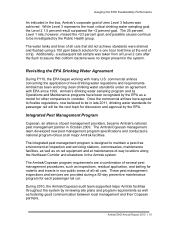Amtrak 2010 Annual Report Download - page 21
Download and view the complete annual report
Please find page 21 of the 2010 Amtrak annual report below. You can navigate through the pages in the report by either clicking on the pages listed below, or by using the keyword search tool below to find specific information within the annual report.
Gauging Our EHS Sustainability Performance
Amtrak EHS Annual Report 2010 | 20
Environmental chapter including compliance requirements and
environmental sustainability initiatives as part of annual Mechanical
department Safety Planner booklet provided to all department employees
(5,000 employees).
Employee Appreciation Day and Health & Safety Fairs—Staffed
environmental table with information on recycling and sustainability
initiatives at 15 locations (6,000 employees).
Amtrak Ink, bi-monthly employee newsletter published by Corporate
Communications—Periodic articles and April “green” issue, delivered to all
employees via U.S. Mail and email (20,000 employees).
A Guide to Amtrak Environmental Programs—Brochure for new employees
contains information on Amtrak Environmental Policy; Environmental
Management System; compliance; sustainability initiatives, (from July 2010,
500 employees).
Recycling communications, including “Amtrak Recycles” logo on station
containers and printed materials; lapel pin for onboard staff; buttons for
employees; recycling poster for trains and stations (6,000 employees).
Establishing baseline measurements for the following indicators—
Water usage
Criteria air pollutants and water pollutant discharge
GHG emissions and GHG savings
Energy use (electricity, fuel)
Recycling levels/waste
Operating expense per passenger mile
The major effort for establishing baseline measurements was the completion of the
first Amtrak greenhouse gas inventory (described elsewhere in this report). In
addition, Amtrak utilized data from its Utilities Management database to establish
baseline measurements for the 2008 and 2009 calendar years for water usage and
energy usage (electricity and fuels for stationary facilities). A recycling database
was developed as part of an existing Environmental Information System (EIS)
database for capturing facility-level recycling data.
The development of the baseline indicators is expected to be completed along the
same timeline as the GHG inventory.
























